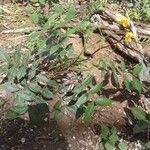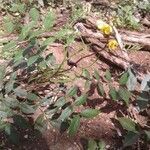Evergreen shrub or small tree up to 4 m, young branches smooth, green. Stipules narrowly lanceolate, acuminate, 3-7 mm long, early caducous. Leaves with 3-4(-5) pairs of leaflets; petiole 1.5-5 cm long, glabrous, grooved; rachis 6-12 cm long, bearing a clavate or conical gland between all except the upper pair of leaflets. Leaflets ovate to ovate-elliptic, 4-11 by 1.5-3.5 cm, glabrous on both surfaces; apex acute to acuminate, base rounded to cuneate; petiolules c. 2 mm. Racemes axillary or terminal, 4-10-flowered, 5-10 cm including the 2.5-4 cm long peduncle; bracts linear-lanceolate, 2-5 mm, caducous; pedicels 1.5-2.5 cm long, glabrous. Sepals yellowish green, ovate-elliptic, unequal, 4-10 mm. Petals bright yellow, ovate orbicular, shortly clawed, glabrous, 1 — 1.5( — 2) cm. Stamens: 2 long with filaments dilated, ribbon-like, 8-11 mm with anthers 8 mm, curved, opening by an apical pore; one with similar anther but with filament 4 mm; 4 with filaments 2 mm long and anthers 4-5 mm; 3 staminodes with anthers flat, suborbicular, non-functioning. Ovary glabrous; style linear; stigma inconspicuous. Pods terete, slightly subquadrangular when fully mature, tardily dehiscent, 6-10 cm, c. 1 cm diam. Seeds 50-70, obovoid, olive, glossy, flat, 5-6 mm.
Shrub, erect, to 3 m high, glabrous. Leaves 6–8 cm long including a terete petiole 15–30 mm long; stipules acicular, caducous; leaflets in 4–5 pairs spaced 15–30 mm apart, ovate, 45–70 mm long, 15–28 mm wide, flat, increasing distally, acute and acuminate; glands 3 or 4, between the lowest leaflet pairs, erect, clavate. Inflorescence of 5–8 flowers, terminal and in upper axils; peduncle 30–40 mm long; pedicels 10–13 mm long; bracts caducous. Petals to 8 mm long. Fertile stamens 7 or rarely 6, with 3 adaxial and rarely 1 abaxial staminodes; fertile filaments distinctly unequal, 2–12 mm long; fertile anthers subequal, 4–6 mm long, the largest with a single U-shaped pore. Pod cylindric, 5–8 cm long, 10–15 mm diam., straight or slightly curved, entire. Seeds lustrous. [This description from the Flora of Australia Volume 12 (Randell Barlow 1998: 133) was under the misapplied name Senna ×floribunda and may require revision-editor, 22 September 2020; see also Green (1998: 171) for treatment, including description, of S. septemtrionalis occurring on Norfolk and Lord Howe Islands.]
Shrubs or small trees, 1-4 m tall. Young branches green, smooth, glabrous. Leaves ca. 15 cm; rachis 6-12 cm, with a clavate or conical gland between all except upper pair of leaflets; stipules early caducous, linear; leaflets 3 or 4 pairs, abaxially farina-white, ovate to ovate-lanceolate, 5-11 × 2-3.5 cm, both surfaces glabrous, base cuneate or narrowly cuneate, sometimes oblique, apex acute to acuminate. Racemes axillary or terminal, 4-10-flowered, 5-10 cm including peduncle 2.5-5 cm; bracts caducous, linear-lanceolate, 2-5 mm. Pedicels 1.5-2.5 cm. Sepals yellowish green, ovate-elliptic, unequal, inner 8-10 mm, outer shorter. Petals bright yellow, ovate-orbicular, 1-1.5(-2) cm, shortly clawed. Fertile stamens 7, unequal, anthers opening by apical pores; 3 staminodes with anthers flat, suborbicular, non-functional. Ovary glabrous; style linear. Legume terete, 6-10 × ca. 1 cm, slightly subquadrangular when fully mature, valves subleathery, tardily dehiscent. Seeds 50-70, olive-colored, glossy, obovoid, flat, 5-6 mm.
Shrub to 2-(3) m high, not armed; twigs glabrous or sparsely hairy, finely ribbed, rounded. Lvs 1-paripinnate, usually glabrous or sparsely ciliate, sparsely hairy when young, petiolate; leaflets ovate-elliptic, usually acuminate, sometimes acute, entire, subsessile or shortly petiolulate, (30)-45-90-(110) mm long, in 3-4-(5) opposite pairs; protruding glands mostly present between each pair of leaflets; stipules deciduous. Infl. axillary, racemose, 6-12-flowered, < lvs; bracts and bracteoles ovate-triangular, caducous, 3-6 mm long. Calyx teeth very unequal, obtuse. Corolla golden yellow, c. 2 cm long; stamens 7; staminodes 3. Pod tardily dehiscent, glabrous, straight, terete, many-seeded, 5-10 cm long; seeds smooth, brown, 4-6 mm long.
Small tree or shrub, up to 4 m high; glabrous throughout with a few strigose hairs on leaflet stalks. Leaves 120-250 mm long. Leaflets 3 or 4 pairs per leaf, ovate, base rounded, symmetrical. Inflorescences of few-flowered, axillary racemes, immersed in foliage. Flowers bright yellow. Flowering time Aug.-Mar. (all year?). Pod shortly stipitate, cylindric 60-150 x 10-15 mm in diam. Valves papery, dark brown, pale along sutures, separating in two layers, internally septate, somewhat pulpy. Seeds two parallel rows, ovate, glossy, lacking areole.
Leaves paripinnate; stipules 5–6 mm long, narrowly triangular, glabrous, subpersistent; petiole 3–7 cm long, glabrous; rachis 4.8–9.4 cm long, glabrous, with a conical reddish gland c.1 mm long between each leaflet pair and terminating the rachis; leaflets in 3–4 pairs, 4.3–9.5 × 1.9–3.2 cm, the distal largest, ovate to elliptic, base cuneate, symmetrical, apex acuminate, occasionally acute, glabrous; petiolules up to 1 mm long, glabrous or with a few appressed hairs.
An erect shrub or tree. It grows 5 m high. The leaflet blades are narrowly oval and taper to the tip. The leaflet blades are 5-10 cm long by 2-3 cm wide. The pair of leaflets at the end are the largest. The flowers are yellow and the petals are 13 mm long. The fruit is a pod 7-8 m long by 1.5 cm wide. The seeds are shiny and olive green. They are 5 mm long by 3 mm wide.
Stamens 10, two fertile with arcuate anthers 7–8 mm long and filaments c.10 mm long, five fertile with short straight anthers 2–4 mm long and straight filaments c.1 mm long on 4 stamens and c.4 mm long on the fifth, three probably sterile with anthers curved into a semicircle and straight filaments.
Short-lived perennial subshrub, shrub or small tree, up to 4 m high. Young stem apices and abaxial leaflet surfaces glabrous. Leaves with elliptic or ovate leaflets in 3 or 4, occasionally 2 or 5 pairs. Ovaries glabrous. Flowers deep yellow.
Inflorescences simply racemose, axillary, 6–10-flowered, 3.5–9.5 cm long including the peduncle; bracts 5–8 × 1–2 mm, narrowly triangular, glabrous, caducous; pedicels 1.5–2.5 mm long at anthesis.
Pod 8–9 cm long, c.1 cm in diameter, straight, grooved, the sutures somewhat impressed, mucronate, glabrous, tardily dehiscent along both sutures.
Petals unequal, the largest 13–15 × 12–13 mm, broadly obovate, retuse at apex, the others broadly elliptic to obovate, acute, orange to yellow.
Ovary c.10 mm long, curved, terete, glabrous; style c.4 mm long, terete; stigma terminal, recessed, surrounded by a fringe of hairs.
Sepals 5, two larger c.8 × 5 mm, three smaller 5–7 × 3–5 mm, elliptic to obovate, glabrous.
Seeds brown, in two rows, c.5 × 3 mm, obovate, flattened, without areoles.
Branchlets pale olive-brown, glabrous, with slight longitudinal ridges.
Shrub or small tree to 5 m high.



